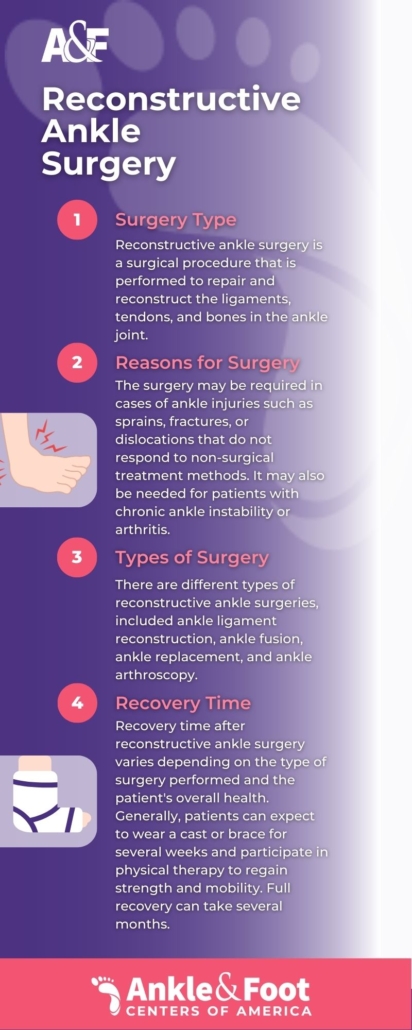Ankle Stabilization or Reconstructive Ankle Surgery?
Photo from Unsplash
Ankle Stabilization or Reconstructive Ankle Surgery?
Ankle stability is a crucial factor in maintaining proper lower limb alignment, joint mobility, and overall functionality. When the ankle joint becomes unstable, it can lead to a variety of problems, such as chronic ankle sprains, pain, and difficulty with weight-bearing activities. In some cases, conservative treatments such as physical therapy, braces, and orthotics may be effective in treating ankle instability. However, in more severe cases, surgical intervention may be necessary. This blog post will explore two surgical techniques for ankle stabilization: reconstructive ankle surgery and lateral ankle stabilization surgery.
Ankle Stabilization Techniques
Before discussing the surgical techniques, it’s important to understand that there are different degrees of ankle instability, ranging from mild to severe. Conservative treatments such as physical therapy, braces, and orthotics may be effective for mild ankle instability, while surgical intervention is often required for moderate to severe ankle instability.
Reconstructive Ankle Surgery
Reconstructive ankle surgery is a surgical technique that involves repairing or reconstructing the ligaments and other soft tissues in the ankle joint. This type of surgery is typically performed when the ankle joint has sustained significant damage, such as torn ligaments or other soft tissue injuries. The goal of reconstructive ankle surgery is to restore the stability of the ankle joint and prevent further damage.
Who is a good candidate for reconstructive ankle surgery? Individuals with moderate to severe ankle instability are usually good candidates for reconstructive ankle surgery. Your doctor will evaluate your condition and recommend the appropriate course of treatment. If conservative treatments have failed to improve your ankle stability, then reconstructive ankle surgery may be the best option.

Types of Reconstructive Ankle Surgeries
There are different types of reconstructive ankle surgeries, including ankle ligament repair, ankle ligament reconstruction, and ankle arthroscopy. Let’s take a closer look at each of these procedures.
- Ankle Ligament Repair: This procedure involves repairing the damaged ligaments in the ankle joint. During the surgery, the surgeon will make a small incision in the ankle and use sutures to repair the damaged ligaments. Ankle ligament repair is typically performed on individuals with mild to moderate ankle instability.
- Ankle Ligament Reconstruction: This procedure involves reconstructing the damaged ligaments in the ankle joint. During the surgery, the surgeon will use a graft (tissue from another part of your body or a donor) to reconstruct the damaged ligament. Ankle ligament reconstruction is typically performed on individuals with moderate to severe ankle instability.
- Ankle Arthroscopy: This procedure involves using a small camera (arthroscope) and specialized instruments to visualize and repair damage to the ankle joint. Ankle arthroscopy is typically performed on individuals with cartilage damage or other soft tissue injuries.
Recovery and Rehabilitation after Reconstructive Ankle Surgery
Recovery time after reconstructive ankle surgery varies depending on the severity of the ankle instability and the type of surgery performed. After surgery, you will need to wear a cast or walking boot for several weeks to protect the ankle joint. Physical therapy is also an important part of the recovery process to regain strength and mobility in the ankle joint.
Lateral Ankle Stabilization Surgery
Lateral ankle stabilization surgery is a surgical technique that involves repairing or reconstructing the lateral ankle ligaments. This type of surgery is typically performed when the lateral ankle ligaments have been stretched or torn. The goal of lateral ankle stabilization surgery is to restore stability to the ankle joint and prevent further damage.
During lateral ankle stabilization surgery, the surgeon will make an incision on the lateral (outer) side of the ankle and identify the damaged ligaments. The surgeon will then repair or reconstruct the ligaments using sutures or a graft. The procedure may also involve the use of anchors or screws to hold the ligaments in place.
Recovery time after lateral ankle stabilization surgery varies depending on the severity of the ankle instability and the type of surgery performed. After surgery, you will need to wear a cast or walking boot for several weeks to protect the ankle joint. Physical therapy is also an important part of the recovery process to regain strength and mobility in the ankle joint.
Comparing Reconstructive and Lateral Ankle Stabilization Surgeries
Both reconstructive ankle surgery and lateral ankle stabilization surgery are effective in treating ankle instability. The choice of surgery depends on the severity and location of the ankle instability.
Benefits and Drawbacks of Reconstructive Lateral Ankle Surgery
The benefits of reconstructive ankle surgery include improved ankle stability, reduced pain, and improved joint function. However, there are some drawbacks to consider, such as a longer recovery time, a higher risk of complications, and the potential for future ankle injuries.
Factors that may influence the choice between the two surgeries include the severity of the ankle instability, the location of the instability, the individual’s age and activity level, and the individual’s overall health.
Speak with Your Podiatrist!
Ankle stability is crucial for maintaining proper lower limb alignment, joint mobility, and overall functionality. In cases of moderate to severe ankle instability, surgical intervention may be necessary. Reconstructive ankle surgery and lateral ankle stabilization surgery are both effective in treating ankle instability. The choice of surgery depends on the severity and location of the instability, as well as other individual factors. After surgery, physical therapy is an important part of the recovery process to regain strength and mobility in the ankle joint. If you are experiencing ankle instability, speak with your foot doctor about the best course of treatment for your individual needs.
